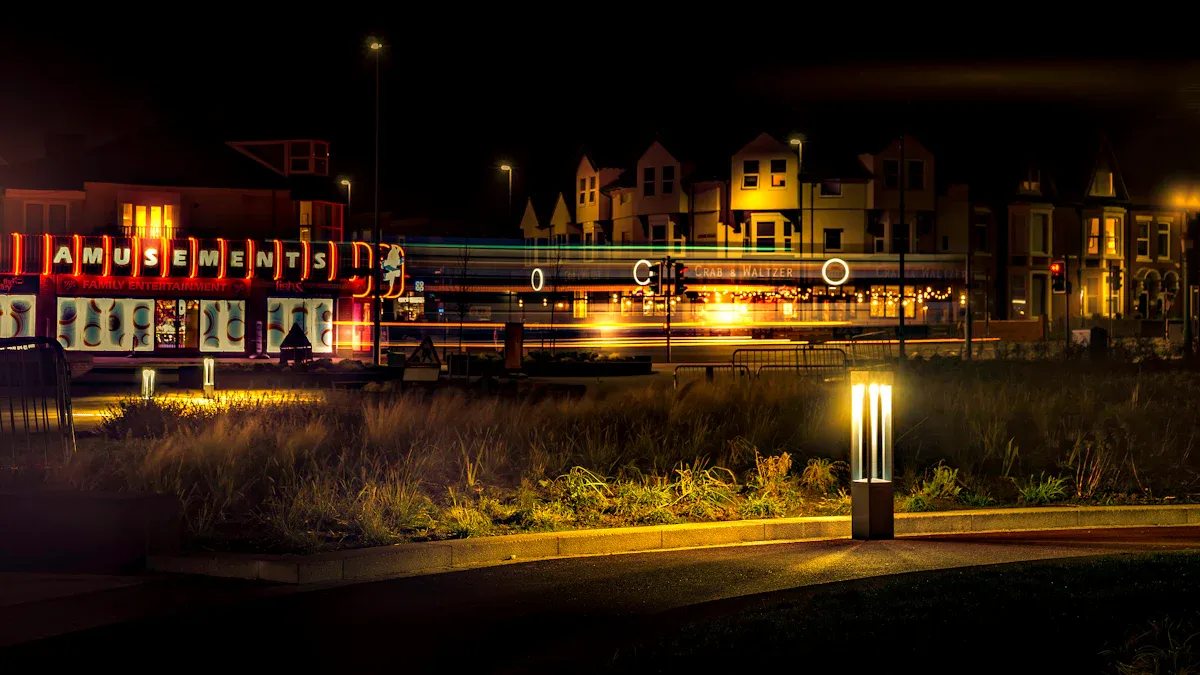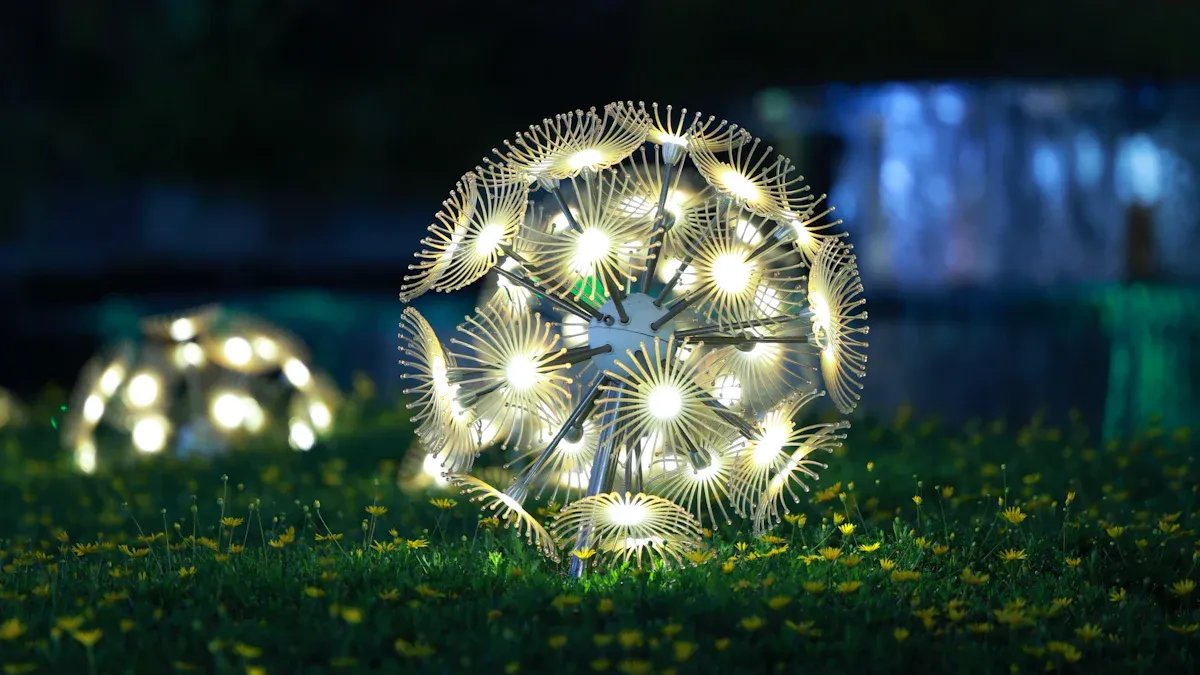Layering Techniques for Effective Outdoor Lighting Design

Transform your yard into a functional and inviting space with Effective Outdoor Lighting. Choosing the right Product, such as a Led Light, can make a significant impact. Layered lighting not only enhances the look of your Home but also adds style and safety. Learn more About Us and discover how ambient and accent lights can elevate your outdoor spaces with this simple and effective approach.
Key Takeaways
Use ambient, task, and accent lights to create a cozy yard.
Pick proper lights for each layer to improve safety and looks.
Clean and check your outdoor lights often to keep them bright and lasting longer.
The Role of Lighting Layers in Outdoor Lighting Design
Ambient Lighting: Setting the First Layer
Ambient lighting is the base of outdoor lighting design. It lights up spaces to make them safe and welcoming. This soft glow sets the mood for your yard or patio. Whether you’re having a barbecue or relaxing, it creates a cozy atmosphere.
Use wall lights, post lights, or string lights for this layer. Big areas like parks need general lighting for even brightness. Pathway lights help you walk safely on paths and driveways.
The Illuminating Engineering Society (IES) suggests using proper light levels for each space.
A study showed how good lighting improves looks and usefulness of homes. Here’s a summary:
Title | Authors | Journal | Year | Pages |
|---|---|---|---|---|
Żagan W, Skarżyński K | Lighting Research and Technology | 2020 | 641-653 |
Mix ambient lighting with other types to make outdoor spaces useful and attractive.
Task Lighting: Lighting Up Work Areas
Task lighting brightens spots where you need to see better. It helps you do things like cook, work, or read outside.
For example, lights under cabinets in outdoor kitchens or spotlights over workbenches are useful. Studies say light levels between 0 and 35 lx make urban areas feel safe and comfortable. This range gives clear vision without being too bright.
Task lighting also keeps you safe. Bright stairs, entryways, and driveways lower accident risks. Combine task lighting with ambient lighting for safer and more useful spaces.
Accent Lighting: Making Spaces Stand Out
Accent lighting adds style and focus to outdoor designs. It highlights special features like buildings, plants, or decorations.
Use uplights to show off trees or downlights for garden beds. Research says accent lighting in parks makes spaces easier to understand and safer. Lighting both vertical and horizontal areas works better than just lighting paths. This makes spaces safer and more beautiful.
Layer accent lighting with ambient and task lighting for a complete design. It makes outdoor areas both useful and pretty. Whether lighting a fountain or patio, accent lighting brings your ideas to life.
Strategies for Effective Light Layering
Balancing Brightness for Cohesion
Outdoor lighting needs balance to look good everywhere. One spot shouldn’t be too bright while another is too dark. Balanced lighting makes your yard feel connected and welcoming. Use layers like ambient lighting, task lighting, and accent lighting to achieve this. Each type has a job, but together they work in harmony.
Soft ambient lights brighten the whole yard evenly. Accent lighting highlights special things like trees or statues. Task lighting makes areas like paths or outdoor kitchens safe and useful. When brightness is balanced, spaces flow smoothly without harsh contrasts.
Tip: Add dimmers to control how bright each light is. This lets you change the mood for different events.
Using Light Intensities to Create Depth
Changing how bright lights are adds depth to your yard. It makes spaces look more interesting and alive. Bright spots grab attention, while softer lights add mystery. Think of it like painting with light.
Use uplighting to show tall trees or cool building shapes. Downlighting looks like moonlight and makes soft shadows. Mixing these methods creates layers that make your yard feel exciting and full of life.
Pro Tip: Put brighter lights near main features like fountains or flower beds. Use dimmer lights farther away to guide the eye and add depth.
Strategic Placement for Maximum Impact
Where you put lights is just as important as the type of lights. Good placement makes your yard prettier, safer, and easier to use. For example, lights along paths and driveways help people walk safely. Lights on stairs and doors lower accident risks.
Here’s why placement matters:
It makes spaces safer by removing dark spots.
It shows off cool features like trees or walls.
It makes people feel secure and keeps bad behavior away.
Plan your lighting based on your yard’s special features. Use accent lighting to show off a tree or wall texture. Place ambient lighting to brighten big areas like patios. Add task lighting for places like outdoor kitchens or seating zones.
Note: Don’t use too many lights. Too much brightness can ruin the natural look and cause glare. Focus on small, well-placed lights to improve the design.
Techniques to Improve Outdoor Lighting
Grazing for Texture and Detail
Grazing is a simple way to show textures outside. Aim light to skim surfaces like stone walls or wooden fences. This makes natural patterns and details stand out. It’s great for showing off special features at night.
Picture a brick wall lit with grazing light. Shadows from the uneven surface add depth and style. A plain wall becomes a beautiful centerpiece. To do this, place the light close and aim it at a low angle. This highlights texture without making the area too bright.
Tip: Use grazing on surfaces like stucco, brick, or rough wood. It adds a classy touch to your outdoor lighting.
Silhouetting for Bold Effects
Silhouetting creates strong, eye-catching outlines. Put a light behind something like a tree or statue. This turns it into a dramatic silhouette. It focuses on the shape, adding mystery and excitement to your yard.
Research shows silhouetting can create emotional feelings. For example, lighting a shrub from behind makes it stand out. This works well in simple designs with clean lines and shapes.
Pro Tip: Try silhouetting to show off cool shapes like plants or sculptures. It’s a fun way to make your yard unique.
Shadowing for More Depth
Shadowing adds layers and interest by mixing light and dark. Shine a light on something like a tree or sculpture. It casts a shadow on a nearby surface, creating a cool effect.
Think of shadowing as telling a story with light. A tree’s shadow on a wall can look like its branches moving in the wind. To get this effect, angle the light to match the object’s shape and surroundings.
Note: Shadowing works best with other techniques like accent lighting. Together, they make a design that feels complete and exciting.
Selecting Fixtures for Outdoor Lighting Design

Picking Fixtures for Different Lighting Layers
The right fixtures are key to good outdoor lighting. Each layer—ambient, task lighting, and accent—needs specific fixtures to work well. For ambient lighting, use post lights, wall lanterns, or string lights. These give a soft, even glow to your yard. Task lighting works best with focused lights like spotlights or under-cabinet lights. These brighten areas like outdoor kitchens or paths where you need clear vision. For accent lighting, try uplights or downlights. These highlight trees, statues, or cool building details.
Tip: Match the fixture type to the lighting layer’s job. This keeps your design useful and nice to look at.
Knowing Color Temperatures for Mood and Use
Color temperature affects how your outdoor space feels and works. Warm tones (2,700K–3,200K) make spaces cozy and relaxing, great for seating areas or gardens. Neutral tones (4,000K–4,500K) are balanced and work well for paths or general lighting. Cool tones (5,000K–6,000K) are bright and clear, perfect for driveways or work areas.
Here’s a simple guide:
Color Temperature Range | What It Does | Best For |
|---|---|---|
Warm (2,700K – 3,200K) | Feels cozy and welcoming | Seating areas, gardens, home landscapes |
Neutral (4,000K – 4,500K) | Balanced between warm and cool | Pathways, building features, general lighting |
Cool (5,000K – 6,000K) | Improves visibility and safety | Driveways, work zones, commercial spaces |
Pro Tip: Use warm tones for relaxing spots and cool tones for safe, bright areas.
Focusing on Energy Efficiency and Strength
Outdoor lights need to handle weather and save energy. Pick fixtures with weatherproof designs, like IP65-rated ones that block dust and rain. For underwater use, choose IP68-rated fixtures. Materials like stainless steel or anodized aluminum stop rust. Shatterproof covers and strong frames make them last longer.
Look for these features:
Weatherproof Designs: Protect against rain, dust, and bad weather.
Rust-Resistant Materials: Help fixtures last longer.
Impact Protection: Keep lights safe from bumps or tough conditions.
Energy-Saving Designs: Lower heat and use less power.
Advanced LED Features: Look for smart controls and better coatings for brighter light.
Note: Clean and check your lights often to keep them working well and lasting longer.
By picking strong, efficient fixtures, you’ll have outdoor lighting that saves energy and lasts for years.
Maintaining Effective Outdoor Lighting
Routine Cleaning and Inspection
To keep your outdoor lights working well, clean them often. Dirt and dust can make lights dim and less attractive. Wipe fixtures with a soft cloth and mild soap. For glass covers, use a gentle cleaner to avoid scratches.
Checking your lights is also important. Look for loose wires, broken bulbs, or wear and tear. Make sure all connections are tight and secure. If you see rust, fix it quickly to stop more damage. Regular care keeps lights bright and helps them last longer.
Tip: Check your lights every three months to find and fix problems early.
Upgrading Fixtures and Replacing Bulbs
Changing your fixtures and bulbs can improve your outdoor lighting. LED bulbs are a smart pick because they save energy and last longer. Some LEDs can work for decades, but most last about 25 years. Over time, even good bulbs can get dim, so watch their brightness.
For big areas, think about citywide upgrades to save money. For homes, choose strong and energy-saving fixtures. Always check how easy it is to maintain your lights and plan regular upkeep.
Pro Tip: Change bulbs in pairs to keep your lighting evenly bright.
Adjusting Lighting for Seasonal Changes
As seasons change, adjust your outdoor lights too. In winter, shorter days mean you need more light at night. Change timers to match earlier sunsets. In summer, focus on making spaces cozy for outdoor fun.
Seasons can also change how light looks. Snow makes areas brighter by reflecting light, while summer leaves might block some fixtures. Move or adjust lights to keep things balanced and highlight important spots.
Note: Use dimmers or smart controls to easily change lighting for each season without buying new fixtures.
Using layers in outdoor lighting can change how your yard looks. Mixing ambient, task, and accent lights makes spaces safe and beautiful. Designing outdoor lighting doesn’t need to be hard. Layering lights shows off your yard’s best parts while keeping it warm and welcoming.
🌟 Begin with small changes! Try layering lights slowly to improve your outdoor area.
FAQ
How can I pick the best lighting layers for my yard?
Think about what you need. Use ambient lights to brighten spaces. Add task lights for work areas. Use accent lights to show off special features.
Will outdoor lights work during bad weather?
Yes! Pick weatherproof lights with IP65 or higher ratings. These protect against rain, dust, and tough weather, keeping lights working well.
How can I save energy with outdoor lighting?
Use LED bulbs. They last longer and use less energy. This helps lower your electricity costs. Choose energy-saving fixtures with smart controls.
Tip: Clean and check your lights often to keep them bright and efficient.
See Also
Enhancing Outdoor Areas With RGB Flood Lights For Events
Illuminating Spaces Beneath Canopies For A Cozy Ambiance
Creative LED Lighting Concepts For Your Outdoor Patio Area
Revamping Outdoor Living Areas With Affordable LED Lighting Solutions
The Impact of LED Technology on Outdoor Lighting Innovations

